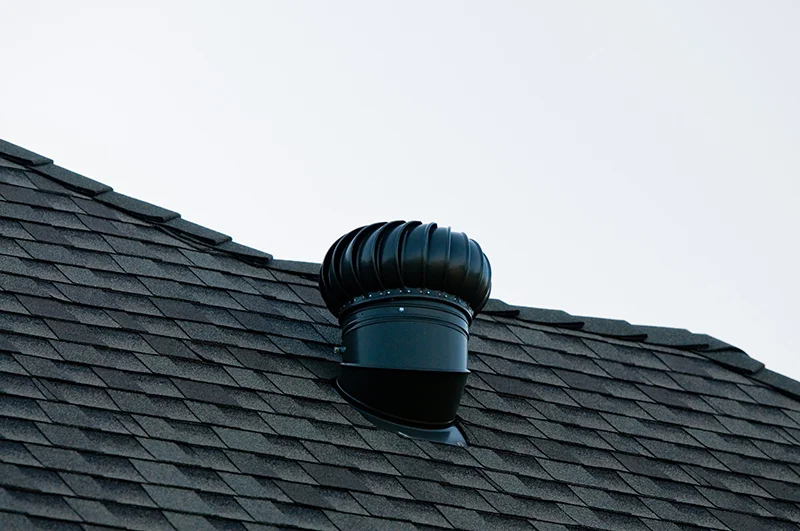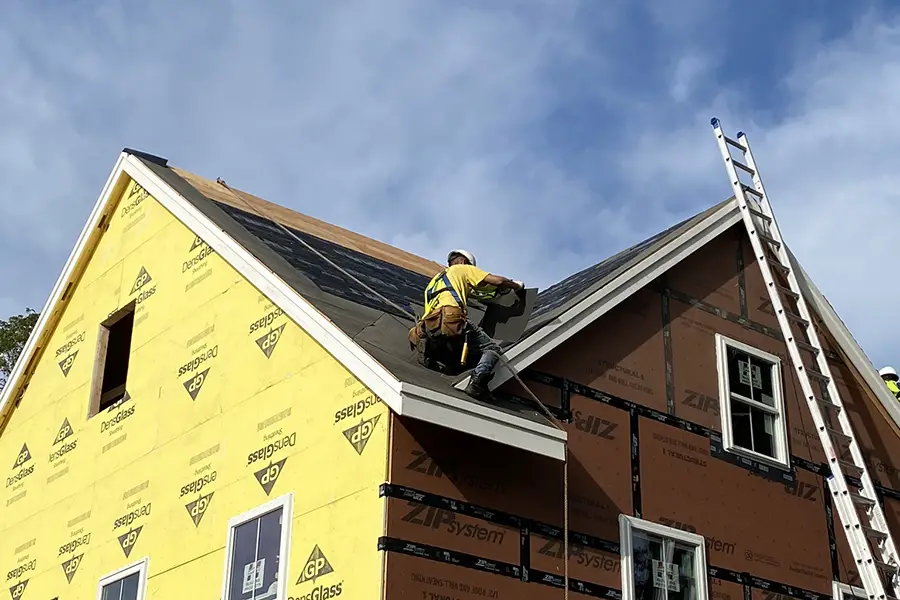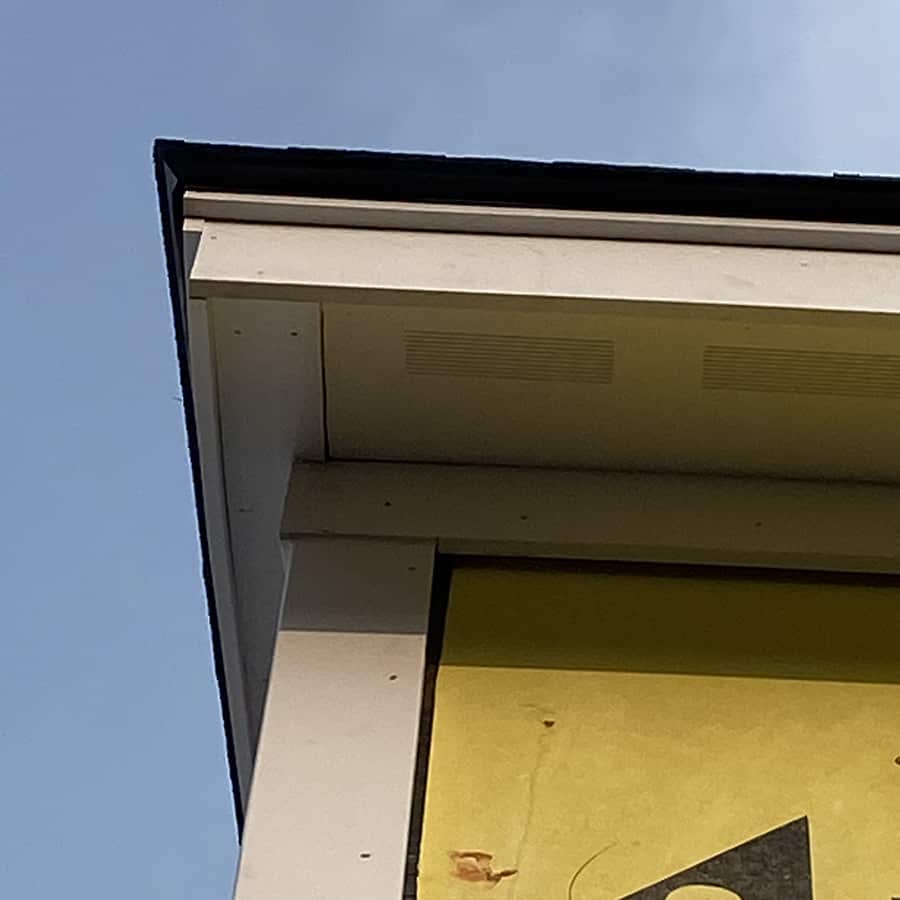As we’re coming up on spring and summer, when the past few years have seen record highs, keeping homes cool and ventilated is an increasing concern. Attic fans are a blanket term for a handful of slightly different products designed to keep the air in your home’s attic moving and maintain a balanced ventilation system.
To clarify, we are not discussing whole-house fans today. Whole house fans are different from attic fans in that they draw out air from the entire house and push it through the attic to the exterior, whereas attic fans draw out just the attic air and send it outside.
Proper attic ventilation requires intake as well as output to create a balanced system. Since hot air rises and attic ventilation is based largely on the concept of convection, soffit vents generally are the best option for passive intake in an attic space. They pull fresh air in from essentially the attic floor and are well protected from the elements. We dive a little deeper into soffit vents here.
Types of Attic Fans
We’re not just talking about a box fan in an old window (what I remember from the house I grew up in). Attic fans are a bit beefier than that and come in a few different shapes and sizes:
Turbine Vent/Fan
Powered by the wind, this round vent has a fan inside that’s very sensitive to air currents. When the breeze hits it just right, it turns the fan, which pulls air up and out of the building below. Turbine fans do not require an energy source, rarely break down, are reasonably compact, and are able to fit on most roofs.
Unfortunately, they are also an “eyesore” to some and can develop annoying squeaks as they age, requiring oiling or maintenance. When paired correctly with intake vents, the convection current keeps the turbine vent working even without a significant breeze.

Gable Vent Fan
This fan mounts vertically behind a gable vent, the flat triangular section of siding beneath a roof’s peak. When the fan’s internal thermostat is signaled, it turns itself on and pushes built-up attic air out from its sidewall position. It is housed entirely inside the attic and requires power, so if electricity is not already available, you will need to run a line and install an outlet.

Electric Roof-mount Fan
There are located partially inside the attic and partially outside of it. Like the gable fan, it requires electricity and also has an internal temperature gauge. Unlike the gable fan, though, these fans typically sit higher up on the roof, right in the path of the hot air as it rises.

Solar Fan
A solar fan is an awesome, cost-effective, low-maintenance option. Once purchased and installed, you never have to pay another penny. It has a panel built into the device suitable for its electrical requirements and offers the same features as any other “hardwired” fan- without the electrical bills. It could be argued that a solar fan saves you money, as maintaining ventilation in the attic can reduce heating and cooling needs in the house’s main area.

Ridge Vent Vs. Attic Fan
We talk a bit more about ridge vents in this article, but we’ll also quickly cover here how they stack up against attic fans for ventilation.
Both ridge vents and attic fans require a passive air intake to replenish removed air, but ridge vents are also passive and allow hot air to leave the attic at the roof peak, while attic fans are mechanical and mostly just push attic air outside.
Ridge vents cover a wider area (essentially the whole roof peak) and operate on their own once installed (other than occasional cleaning if needed). Ridge vents can be retrofitted but are best installed during the initial build and could be daunting for DIYers. Attic fans require power, setup, and occasional attention from the homeowner but have a smaller footprint and are less daunting from a cutting-a-hole-in-my-roof standpoint.
It is not ideal to pair ridge vents with attic fans. While both are designed to move warm air out through your roof and both pair well with soffit vents to create effective airflow circulation, they are not designed to work together. Attic ventilation depends on cycling cool air in from below and warm air out through the top. Placing a powered fan near a ridge vent high on a roof may result in air being pulled down or laterally from the ridge vent, rather than up through the soffit as intended. This interference with the airflow system could nullify its intentions and even create an opportunity for moisture to be pulled back into the attic during storms, which certainly is not the goal!
If your home already has a ridge vent, it’s probably best to stick with that passive ventilation rather than try and compete with it with a powered fan.
Why should I get an attic fan?
Having information on your side is always good when working on any home project. Make sure you calculate the amount of ventilation area required by the IRC for your home, or you could even schedule an attic inspection offering thermal imaging to learn more about potential problem areas needing attention and get a professional opinion.
Consider average summer temperatures in your area. Perhaps your attic isn’t really getting “extremely” hot – it’s just hot in comparison to the conditioned air in the rest of the home.
It may seem counterintuitive at first, but in the wintertime, it’s ideal to have a cold and drafty attic. Your insulation, if it’s doing its job, will keep the house below warm. Healthy attic airflow is especially important in the winter. If the cold outside air meets the warm moist air rising from your home and stays put in your attic instead of cycling through, that moisture then seeps into your insulation, your rafters, your joists and your roof’s sheathing. This minimizes the effectiveness of your insulation, increasing heating costs, and creating mold, mildew, ice dams, and potential rot.
Year-round, healthy attic airflow is essential! Here are some attic fan benefits to consider:
- They help keep your house cool in summer and your insulation dry and effective in winter. This takes the pressure off of your HVAC system because your AC just focuses on cooling the air in your living space rather than fighting against temperature extremes encroaching from the attic.
- This naturally increases your energy efficiency.
- Attic fans can be really helpful towards cooling down your second story, as removing excess hot air from above allows air to continuously filter up and out of the house, drawing cooler air from below up to the warmer second floor.
- Decreases the possibility of damage to your roof. Some attics can reach upwards of 150 degrees Fahrenheit in the summer, and extended extreme temperatures degrade your shingles and other roofing components.
- Supports attic insulation. Again, proper airflow helps everything you already have work better!
- If you go the solar route, a solar fan is free once installed! And who doesn’t love free?
So, do attic fans really work?
Yes, they do work so long as they are paired with the appropriate intake vents.
Attic fans won’t work well without suitable passive intake in the attic itself- without that, their motored ventilation could end up pulling cool air from inside your home in the summer, or heat from your home in the winter if your attic isn’t properly air-sealed.
As attic ventilation of some type is required by most building codes, an attic fan might be your best best for a retro-fit solution that packs a punch. Just be sure to balance the system and put the right size in for your space!




